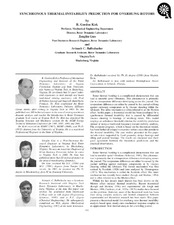| dc.contributor.other | Turbomachinery Symposium (32nd : 2003) | |
| dc.creator | Kirk, R. Gordon | |
| dc.creator | Guo, Zenglin | |
| dc.creator | Balbahadur, Avinash C. | |
| dc.date.accessioned | 2017-10-04T23:47:48Z | |
| dc.date.available | 2017-10-04T23:47:48Z | |
| dc.date.issued | 2003 | |
| dc.identifier.uri | https://hdl.handle.net/1969.1/163296 | |
| dc.description | Lecture | en |
| dc.description | Pg. 121-136 | en |
| dc.description.abstract | Rotor thermal bending is a complicated phenomenon that can lead to unstable spiral vibrations. This phenomenon is primarily due to a temperature difference developing across the journal. The temperature difference can either be caused by the journal rubbing against stationary components or by viscous shearing within the lubricant. The latter mechanism is often referred to as the Morton effect. In this paper, a theoretical model has been developed for a synchronous thermal instability that is caused by differential viscous shearing in bearings of overhung rotors. This model employs an unbalance threshold criterion for instability prediction instead of using a traditional frequency-domain stability analysis. The computer program, which is based on the theoretical model, has been further developed to examine various cases that pertain to this thermal instability. The case studies presented in this paper include rotors supported by fixed geometry design bearings and tilting pad journal bearings. The results are discussed and show good agreement between the theoretical predictions and the practical observations. | en |
| dc.format.medium | Electronic | en |
| dc.format.mimetype | application/pdf | |
| dc.language.iso | en | |
| dc.publisher | Texas A&M University. Turbomachinery Laboratories | |
| dc.relation.ispartof | Proceedings of the 32nd Turbomachinery Symposium | en |
| dc.subject.lcsh | Turbomachines | en |
| dc.title | Synchronous Thermal Instability Prediction For Overhung Rotors. | en |
| dc.type.genre | Presentation | en |
| dc.type.material | Text | en |
| dc.identifier.doi | https://doi.org/10.21423/R1Q363 | |


